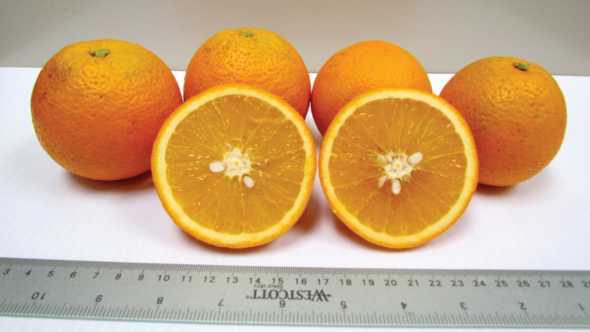Florida Citrus Connecting The Dots On Promising New Selections

UF ‘950’ Photo courtesy of UF/IFAS and Florida Foundation Seed Producers Inc.
UF/IFAS’ ‘950’ mandarin (U.S. PP23,359) was made available to the industry in the first suite of FAST TRACK selections and was highlighted in the April 2013 edition of “Citrus Nursery Source.”
‘950’ is a seedless diploid mandarin that remains seedless in all circumstances, regardless of exposure to other pollen. The fruit is approximately the size of a clementine, matures in December, peels quite easily, and has dark orange internal and external color. The December ratio ranges from 13 to 16 and produces excellent flavor. The sections separate cleanly and have a firm and pleasant “pop” when eaten. The fruit is sturdy and has performed well in limited postharvest analysis. If horticulturally successful, ‘950’ will clearly compete in the very low-seeded or seedless mandarin category against all competition in the December market window. Growers in the FAST TRACK program have small, experimental trees in the ground, none of which are fruiting. However, mature producing trees at the Citrus Research and Education Center (CREC) in Lake Alfred continue to produce fruit and appear to have above average performance in the presence on HLB. The trees at the CREC are on a relatively standard nutrition program (not what would be typical for a fresh fruit block) and are grafted on an unreleased rootstock.
Based on all of the factors above, a few registered Tier I FAST TRACK growers recently elevated ‘950’ to Tier II status. All registered Tier I growers of ‘950’ were notified of its elevated status and were given the opportunity to move to Tier II as part of the Early Option process. At this time, sufficient quantities of ‘950’ have been requested to offset patent costs. Florida citrus nurseries have been notified of the movement to Tier II and have been given the opportunity to increase budwood under a license agreement with New Varieties Development & Management Corp. (NVDMC) and position themselves to increase budwood and produce Tier II trees. At this time, the universe of potential customers for ‘950’ is comprised only of those growers registered in Tier I of the program for this selection. As soon as the first ‘950’ tree is sold, the clock starts ticking on a five-year production head-start as part of the incentive/reward package to entice growers to participate in Tier I of the FAST TRACK program. At the conclusion of the production head-start, other growers will be able to enter the program under Tier III.

Due to its attractive features, ‘Bingo’ has grabbed the attention of growers.
Photo by Peter Chaires
Did I Hear A Bingo?
I have written a few times in recent history about ‘7-6-27,’ a mandarin variety that has since been renamed ‘Bingo’ (U.S. PPAF). ‘Bingo’ was offered to the industry in the third FAST TRACK suite, and was instantly elevated to Tier II based on its superior early season quality (October/November maturity, deep-orange color, easy peel, seedless, excellent flavor, productive), but also the apparent durability/tolerance of the original tree at the CREC on its own roots.

‘Bingo’
Photo by Tyler Jones
Though unsure of rootstock compatibilities and general performance as a grafted tree, the upside market potential of a successful ‘Bingo’ launch was enough to generate orders for approximately 150,000 trees at the outset. The first ‘Bingo’ Tier I and Tier II trees have gone to the field, and early orders will be fulfilled throughout the next year. At the same time, the ‘US Early Pride’ (USDA-ARS’ low-seeded variant of the early season ‘Fallglo’) has been leading the pack for specialty propagations and ‘UFGlow’ (U.S. PPAF, Suite III easy peel seedless October/November maturity) has been planted in smaller trial blocks. It has been interesting to note the impact that ‘Bingo’ has had on the elevation of ‘950’ to Tier II status. Growers and packers needed something to follow on the heels of the October/November window. Though growers are expecting a two- to three-week lag between ‘Bingo,’ ‘US Early Pride,’ and the future ‘950’ harvest, it is the first step in connecting the new variety dots on the fresh side of the ledger.
Other FAST TRACK selections, such as ‘Seedless Snack’ (N40W-6-3, U.S. PPAF, Suite I, seedless, peelable, firm productive mandarin maturing in late October/early November) and ‘C4-15-19’ (U.S. PP26,086, October/November seedless high brix mandarin) will likely be evaluated for their ability to fit into the mix. The Roe Tangerine, now more widely available, may be able to cover the seedless easy peel gap between ‘Bingo’ and ‘950.’ It should continue to be noted that though the selections being elevated through the FAST TRACK process are exciting to growers, these remain largely untested and much will be learned over the next few years about their long-range potential.

Florida EV1
Photo courtesy of UF/IFAS
Tracking Trendlines
While fresh growers and packers have been playing connect the dots with new mandarin selections, orange growers have been innovating in their own way. ‘Florida EV-1’ (U.S. PPAF), ‘Florida EV-2’ (U.S. PPAF), and Valquarius ‘SF14W-62’ (U.S. PP21,535) early maturing Valencia oranges are being propagated and planted. ‘OLL-8’ (U.S. PP26,087), — largely due to larger supplies of budwood — has led the charge and has already become the fourth most propagated orange in Florida for processed and fresh growers. As budwood is increased for the other new oranges, we can expect to see increased plantings. However, growers who have traditionally grown oranges exclusively for the processed market are expressing strong interest in fresh specialty selections. These growers see market potential in both processed and fresh markets and are interested in diversification. Though the FAST TRACK process is familiar to fresh growers, this is new territory for processed growers. The FAST TRACK model is periodically evaluated for its performance and ability to maximize the potential of new citrus selections and the health and well-being of the Florida industry. These new factors will certainly be a consideration throughout the process.
Making Lemonade Out Of Lemons
This past year, Florida planted more lemons than grapefruit. If the new bactericide products prove successful on grapefruit trees, this scenario is likely to change fast, but it is an interesting phenomenon. Growers gravitated to lemons, mainly due to their ability to withstand HLB. DPI has had a hard time maintaining any lemon budwood. As soon as lemon budwood is ready, it is cut and shipped.
Traditional lemon varieties are being propagated, as is the Harvey lemon, an older line that has not been planted in commercial quantities for many years. Some of the lemons will be packed, but at least three processors are considering the market opportunities. It is a reasonable assumption that processing plants are feeding into growers’ decisions to plant lemons. UF/IFAS has some interesting true lemons in its pipeline, as well as lemon and lime hybrids. It is too early to tell if this lemon momentum will generate demand for inclusion of acid-fruit selections in early release programs. Stay tuned.










